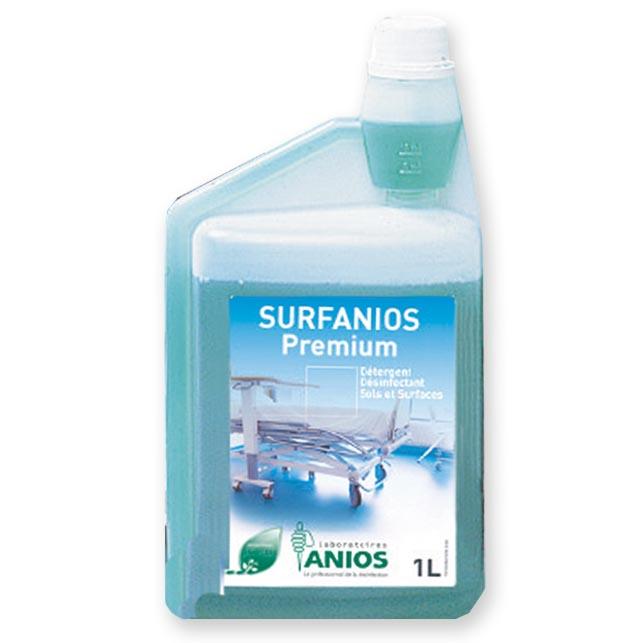DETERGENT/DISINFECTANT for surfaces, 1 l tin
Valid Article
DETERGENT/DISINFECTANT for hard surfaces
Definition
Combined detergent-disinfectant product.
A non-sterile liquid with a neutral or alkaline pH intended to be used as detergent-disinfectant for the cleaning AND the disinfection of hard (non-porous) surfaces: floor, walls and non-invasive medical equipment (e.g. Mayo table, operating table, operating lamp...). This solution is diluted prior to use according to the manufacturer's instructions.
Specifications
Ideal properties for all products used for healthcare environmental cleaning:
- Nontoxic: it is not irritating to the skin or mucous membranes of the user, visitors and patients.
- Easy to use: directions for preparation and use are simple and contain information about PPE required.
- Acceptable odor: it does not have offensive odors to users and patients.
- Solubility: it is easily soluble in water (warm and cold), drinking water can be used for the dilution, not necessary to use distilled or demineralized water.
- Efficacious cleaning: it removes dirt, soil, and various organic substances.
- Broad spectrum disinfectant: it has a wide antimicrobial range, including those pathogens that are common causes of HAIs (Hospital Acquired Infection) and outbreaks.
- Rapid action: it is fast acting and has a short contact time.
- Remains wet: it keeps the surfaces wet long enough to meet recommended contact time with a single application.
- Not affected by environmental factors: it is active in the presence of trace quantities of organic material and is compatible with cleaning supplies.
- Material compatibility: it is proven compatible with common healthcare surfaces and equipment.
- Nonflammable: it has a flash point of more than 65°C. (Flash point = lowest temperature at which the vapors of a volatile material ignite if given an ignition source)
- Stability: it is stable in concentration and use dilution.
Quality Standards Comment
The standard European approach for disinfectant validation is divided up into three phases:
- Phase 1: Basic Suspension Tests for fungicidal and bactericidal activity
- Phase 2
- Step 1: Suspension and surface tests to evaluate the activity of a disinfectant against a range of microorganisms under conditions which more closely simulate practical use.
- Step 2: Surface test (= carrier test): surface samples are inoculated with a selection of microbial challenge organisms. A disinfectant is applied to the inoculated surfaces and exposed for a predetermined contact time.
- Phase 3: Field Trial
Applicable standards for the antimicrobial activity
- EN 1275:2006: Chemical disinfectants and antiseptics - Quantitative suspension test for the evaluation of basic fungicidal or basic yeasticidal activity of chemical disinfectants and antiseptics - Test method and requirements (phase 1)
- EN 1040 : 2006 : Chemical disinfectants and antiseptics - Quantitative suspension test for the evaluation of bactericidal activity of chemical disinfectants and antiseptics – Test method and requirements (phase1)
- EN 13727+A2: 2015: Chemical disinfectants and antiseptics - Quantitative suspension test for the evaluation of bactericidal activity in the medical area - Test method and requirements (phase 2, step 1)
- EN 13624:2013: Chemical disinfectants and antiseptics. Quantitative suspension test for the evaluation of fungicidal or yeasticidal activity in the medical area. Test method and requirements (phase 2, step 1)
- EN 14476:2013+A2 : 2019: Chemical disinfectants and antiseptics - Quantitative suspension test for the evaluation of virucidal activity in the medical area - Test method and requirements (Phase 2/Step 1)
- EN 13697 : 2015 + A1 : 2019 : Chemical disinfectants and antiseptics – Quantitative non-porous surface test for the evaluation of bactericidal and/or fungicidal activity of chemical disinfectants used in food, industrial, domestic and institutional areas – Test method and requirements without mechanical action (phase 2, step 2)
Regulatory
The combined detergent / disinfectant for surfaces has the status of biocide (group I PT2), some also the additional status of medical device (Class IIa) and must comply with applicable regulations:
- for biocides: BPR (Biocidal Product Regulation): Regulation EU n° 528/2012 concerning the making available on the market and use of biocidal products
- for medical devices: MDR: Regulation EU n° 2020/561 on medical devices (amending Regulation EU n° 2017/745 about the dates of application of certain of its provisions)
Technical specifications
Product composition
detergent active principles
antimicrobial active principles
- quaternary ammonium of the fourth generation (or higher) such as DDAC = Didecyldimethylammonium chloride or another equivalent biocidal product such as DDA = Dodecylamine = laurylamine
- combined with another disinfectant: biguanide derivative, isopropanol, alkylamine, amino acid, ethanol, ..
Intended use
- intended (by the manufacturer) to be used on hard surfaces and non-invasive medical equipment
- with standard activity at the defined use concentration & contact time.
- tested in clean and dirty conditions according the European standard for activity on non-porous surfaces against:
- bacteria (mandatory test organisms): E. Hirae, E. Coli, P. Aeruginosa, S. Aureus
- Candida albicans
- enveloped viruses such as HBV, HCV, HIV and influenza virus
Label: according the BPR
- Hazard statement pictograms are correct
- Language of the label
- No misleading text in respect of the risks to health or environment
- Identification of every active substance and its concentration in metric units
- Directions for use and for safe disposal
- Batch number / expiry date clearly written
- Storage conditions written
Packaging & Labelling
- 1 or 2 liter bottles, with pump or dosing system
- Packing group: III
Instructions for use
Concentrated solution to be diluted before use. Prepare the solutions according to the manufacturer's instructions in a designated cleaning service area. Standardized containers (for measuring solutions) and easy to use pictorial job aids (e.g., posters) should be used. Respect the dilution and the indicated temperature of the water. The concentrated solution must to be added to the water and not the other way around.
Dilution at 0.25%: 20 ml = 1 stroke of dosing pump for 8 litres water.
Contact time: minimum 15 minutes
All containers used for storing solutions of environmental cleaning products should:
- Be clean, dried before refilling, clearly labeled, and have an expiry date
- Never be topped up: use the container until the indicated expiry date, after that it should be disposed, or until the container is empty, whichever comes first.
Apply according to instructions for use on a visually clean and dry surface.
Do not rinse.
Make sure to wet surfaces completely, use a wipe or towel, keep them wet for the whole exposure time.
Use periodically / on a scheduled basis a rinse step to remove residues from surfaces.
Precautions for Use
Use disinfectants with care. Always read the label and product information before use. Do not mix with other products.
Hazardous product: Check the SDS information supplied with the product as the information may differ according to the manufacturer!
PPE is required to prevent: exposure to microorganisms, exposure to cleaning chemicals (the products are often very irritating when undiluted), the spread of microorganisms from one patient care area to another. A protective apron and household gloves are recommended, with additional eye protection (goggles or safety glasses) when preparing the solutions. (see related articles)
If disinfectant/detergent is used for the routine cleaning of all surfaces, it is important that it does not impart a false sense of security. Bacteria will persist in the environment despite the use of a disinfectant cleaner, and attention to standard infection prevention practices remains essential.
What to do in the event of exposure:
- Skin contact: rinse immediately with plenty of water
- Eye contact: rinse immediately with plenty of water or better still physiological saline, including under the eyelids, for at least 15 minutes.
- Ingestion: do not induce vomiting
Storage
Storage
Between 5 and 35ºC, in a dry and well ventilated place, keep only in original container.
Shelf life: closed tins: 3 years, mondose sachets: 18 months
Do not prepare the solutions in advance: a diluted solution should not be kept for more than 24 hours (risk that dangerous microorganisms will start growing in the diluted solution due to bacteria in chlorinated water).
Transport Dangerous Goods
- check the UN code for transport on the SDS (UN1903)
- Proper shipping name: UN1903=DISINFECTANT, LIQUID, CORROSIVE, N.O.S.(n-(3-aminopropyl)-n-dodecylpropane-1,3-diamine, didecyldimethylammonium chloride)
Waste management
- Avoid release to the environment: very toxic to aquatic life with long lasting effects
- Collect spillage
- Dispose of contents/container to location in accordance with local and regional/ national/ international regulations
Recommended literature:
Best Practices for Environmental Cleaning in Healthcare Facilities in Resource-Limited settings, CDC 2019





